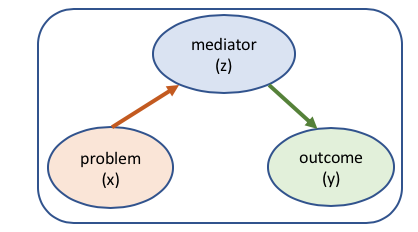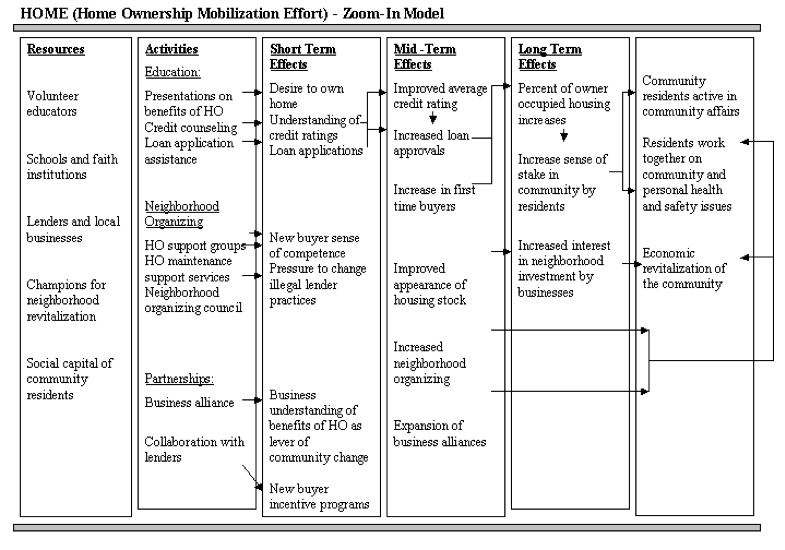Module 2 Chapter 3: Logic Models and Theory Informed Intervention
In our earlier course you learned about the relationship between theory and research. In this course about understanding social work interventions the relationship between theory and intervention takes center stage. The design of an intervention is typically informed by theory and evidence, and the research about that intervention further develops theory and evidence. Over time, with repetitions of this cycle, social workers have sufficient evidence to inform their practice decisions. The logic model is an approach to systematically defining an intervention and relating the theory and evidence base to its development.
In this chapter, you learn:
- how theory and logic models inform intervention design
The Role of Theory in Intervention Design
The PICO or COPES process helped define the practice problem or question. The next step in the process of designing an intervention is to apply theory in mapping the mechanism of change. Evidence about mechanisms of change answers questions of how change occurs or is facilitated rather than restricting focus on what changes occur. In other words, mechanisms of change research is about change processes, not just change outcomes. For example, a body of literature suggests that
In our earlier course you learned to understand social work problems and social phenomena, as they occur across diverse populations, in terms of theory and evidence. This is the change theory and evidence applied by intervention planners. Theory helps planners identify “targets for change”—leverage points where it makes the most sense to intervene and how intervening at those points might lead to the desired change outcomes (Fraser, Richman, Galinsky, & Day, 2009). Practical targets for change are limited to factors that can be modified through intervention; it is impractical to target phenomena that cannot be modified through intervention (e.g., exposure to past events cannot be undone, but reactions/responses to them might be modifiable). In the empirical literature, these factors are often identified as mediators.
This diagram shows the rationale involved: the outcome (y) is considered a direct effect of the problem (x), but the relationship between them is influenced or controlled by a mediating process (z). This mediator becomes a prime target for change—by changing it (z), the problem (x) might have a different impact or outcome (y).

For example, empirical evidence tells us that a specific biological process in the brain (accumulation of amyloid plaques) is a direct cause of Alzheimer’s disease. The problem (x) in this case is amyloid plaque formation in the hippocampus and thalamus regions and causes—or at least heavily influences—the outcome, which is Alzheimer’s Disease (y). Recent evidence identified a mediator of this relationship (z)—lack of sleep causes an accumulation of beta-amyloid proteins that “clump” together forming plaques in the human brain (Shokri-Kojori et al., 2018). While we are not able to change the neurobiology whereby plaque formation (x) causes Alzheimer’s Disease (y), we might intervene around the mediator, lack of sleep (z) to help prevent or delay the onset of Alzheimer’s disease due to beta-amyloid plaque formation. Evidence about lack of sleep as a mediator points to a potentially modifiable intervention target: interventions to promote good “sleep hygiene” practices. This is suggested because beta-amyloid increased by about 5% with study participants losing one night’s sleep—it is a cellular waste product that clears away during sleep. It is unknown whether or to what extent a night of rest can reverse the increase in beta-amyloid that accumulated during the sleep deprivation period (NIAAA, 2018).

Ideally, intervention plans are shaped by causal evidence, not merely correlational evidence. Systematic intervention planning and design proceed from this phase to the creation of a logic model.
Logic Models Explained
A logic model is a conceptual map for a planned intervention, one that shows the logical connections between inputs and outputs in the intervention process and the theory of change (mechanisms of change) underlying the intervention plan (Fraser et al., 2009; Harris, 2010). Inputs are those core elements and resources necessary for implementing the planned intervention. These inputs include personnel, time/effort, space, finances, supervisory, technology, materials, and other resources necessary to deliver the intervention (Harris, 2010). Outputs, on the other hand, are the changes anticipated to result from the planned intervention. The outputs include initial/immediate products or outcomes (proximal outcomes), intermediate impacts or outcomes, and long-range/final outcomes (distal outcomes) associated with the planned intervention (Kapp & Anderson, 2010). The logic model serves the following purposes (adapted from Harris, 2010, p. 56):
- mapping an intervention during planning and evaluation phases;
- documenting the reasoning behind the intervention activities;
- “a tool to facilitate stakeholder insight and reflection”;
- “a tool to inform monitoring and the development of benchmarks” for evaluating the intervention.
Here is a sample template for an intervention or program logic model. Inputs and Outputs/Outcomes were previously described. Activities are those change-producing processes involved—the crucial intervention components informed by evidence. Activities and processes might be separated into “staff activities” and “program processes” to distinguish between what is delivered (staff activities) and what clients do (program processes) for a more nuanced logic model (Kapp & Anderson, 2010). Note that a separate logic model should be developed for each intervention goal if multiple goals are targets of a single intervention, program, or policy.

Here is an example of a completed logic model from the HOME intervention (Home Ownership Mobilization Effort) in the United Kingdom, an intervention to improve communities through increased home ownership (retrieved from https://ctb.ku.edu/en/table-of-contents/overview/models-for-community-health-and-development/logic-model-development/example).

Stop and Think
 Take a moment to complete the following activity.
Take a moment to complete the following activity.
Scenario: A county wishes to intervene to reduce severe health disparities between its urban and suburban populations. Their search for evidence led them to an intervention plan that increases safe, appealing spaces and opportunities for physical activity and provides affordable, appealing access to healthful food. Thinking about how their logic model might be constructed, answer the following multiple-choice questions.
Chapter Summary
In this brief chapter you were introduced to the logic model for planning and evaluating interventions. This is an approach that clearly identifies the logic in designing an intervention to achieve specified outcomes based on the intervention “inputs,” activities, and processes. A logic model is founded on theory and evidence informing the choices of inputs, activities, and processes, as well as determining the likely short- and long-range impacts of the intervention. In our next chapter, we consider approaches to locating that evidence.
